10 Top AI Use Cases in E-Commerce
Interested in the different AI use cases in e-commerce?
According to Forbes, 78% of e-commerce brands admit they have already incorporated AI into their stores or plan to do so.
In this article, we'll go over 10 use cases of AI in e-commerce that retailers utilize to boost their sales, productivity, and business planning.
TL;DR
The best AI use cases in e-commerce are:
- Personalizing the customer experience with AI recommendations, site search, and cross-selling.
- Improving the pre-purchase and post-purchase customer experience with AI chatbots.
- Optimizing your logistics with demand forecasting and inventory management.
- Keeping your website secure by detecting fraudulent transactions.
- Website hyper-personalization, where you customize your website's home page to give your users contextual product recommendations.
- Creating unique customer experiences like virtual try-ons of products that act as fitting rooms.
- Analyzing consumer data with AI to get insights into your customer segments and their preferences.
- Optimizing your pricing strategy and setting up dynamic pricing.
What are the best AI use cases in e-commerce?
The best use cases of AI in e-commerce are:
#1: AI Product Recommendations
Online retailers are using AI to recommend products to their customers to make sure that they are finding the right fit for their needs.
The technology uses customer behavior data (e.g., past purchases, pages browsed, and preferences) to recommend the most relevant product for each user.
These product recommendations can appear in:
- A conversation with an AI chatbot.
- On the sales and category pages with a section titled ''recommended for you'' or ''picked for you''.
- While searching in the search bar.
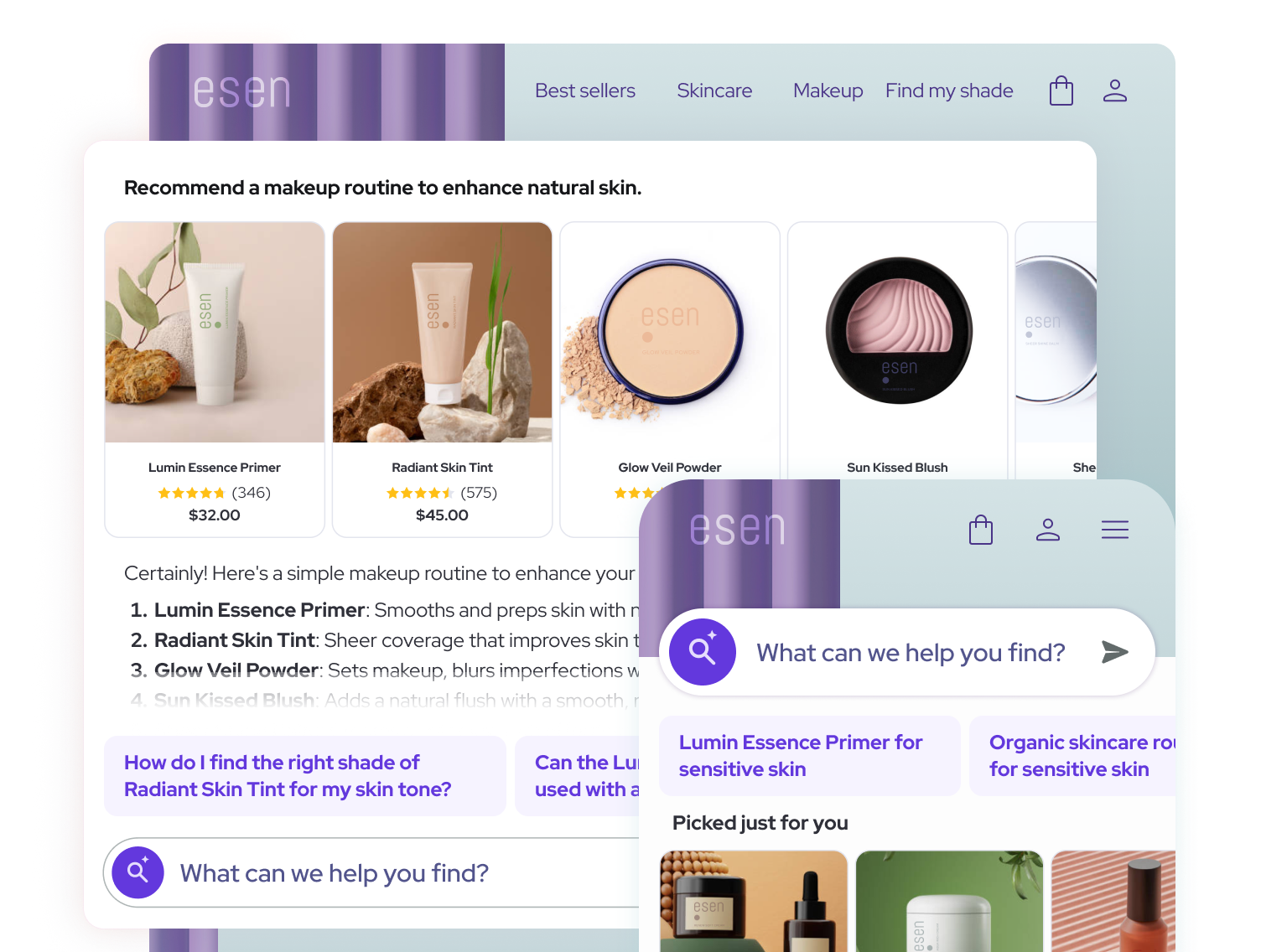
Big Sur AI (that’s us) provides your customers with personalized product recommendations during conversations with our AI sales agent or on product pages.
The more customer data your AI tool can access, the more tailored the recommendations will be.
These recommendations adjust in real-time as the tool learns about your shoppers.
Adamapp research shows that AI-driven product recommendations can result in an 11% increase in average order value (AOV) and a 26% increase in conversion rates.
Example: Esen utilizes Big Sur AI to recommend make-up routines to customers with specific demands, such as a make-up routine that enhances the natural skin.
The tool can offer a product bundle of multiple products that are used together to achieve the user's goal.
The brand is also prompting its users to search for different kinds of make-up (e.g., for sensitive skin) as the software has found that this brings them the highest conversion rates.
Big Sur AI's question prompts are optimized for conversions on a data-driven basis.
The tool takes into consideration what would most likely lead to a conversion for each consumer.

✅ Personalize your customers' shopping experience to increase your conversion rates and create a smoother shopping journey.
❌ The algorithm requires user data to give accurate product recommendations, which only a few products can gather efficiently while respecting users' privacy (Big Sur AI is one of them).
#2: AI Site Search
E-commerce site search statistics show that 43% of users on e-commerce websites go directly to the search bar, which is why retailers have been investing in AI-powered semantic search.
Online brands are setting up an AI site search that can understand the user intent of the search queries instead of only matching keywords to product titles.
The goal is to minimize the ''null'' results that users get when their keywords do not match anything and to optimize for non-product queries (e.g., searching for the return policy).
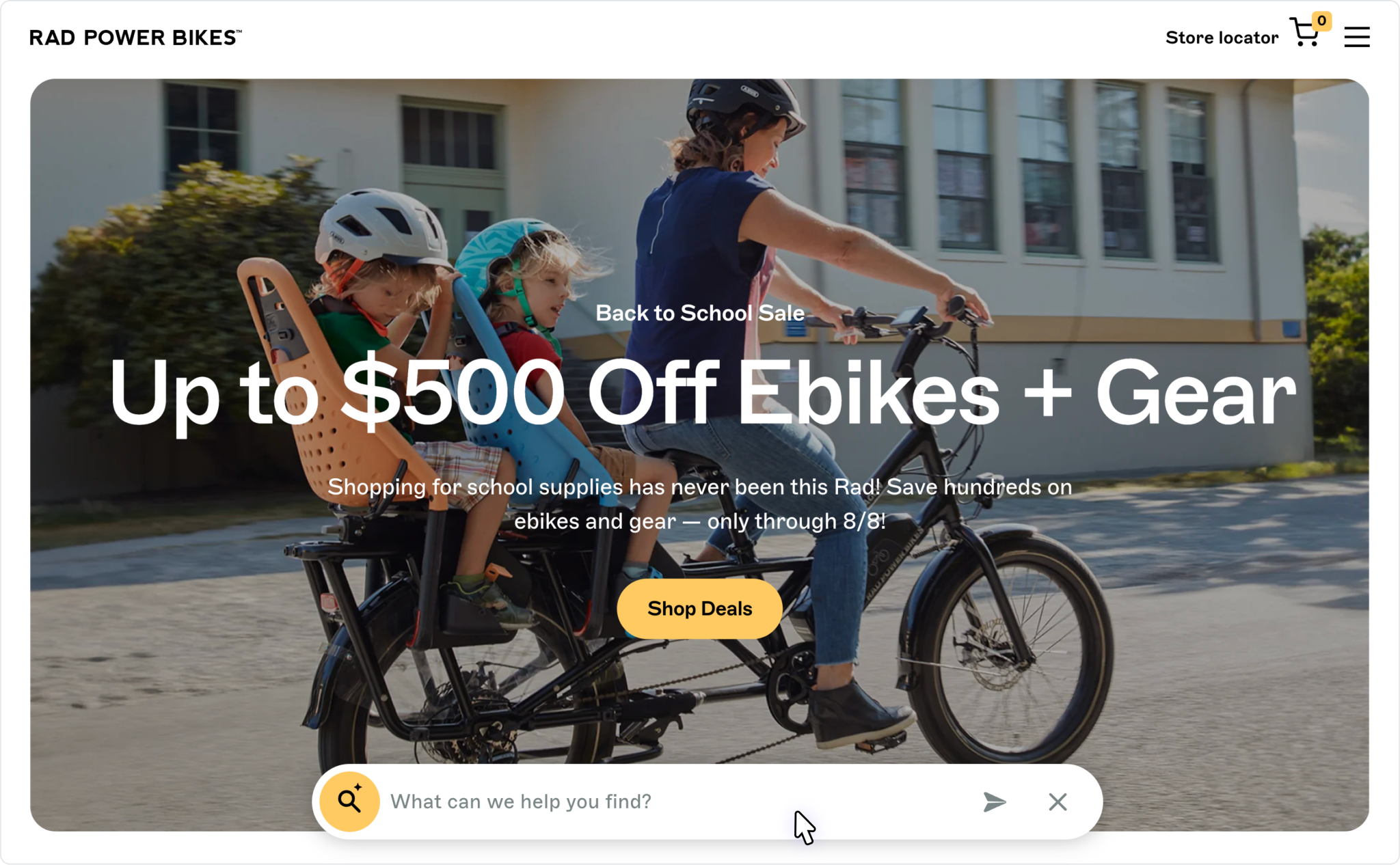
Big Sur AI is more than site search. The AI Sales Agent turns into a conversational chatbot to answer your customer’s search queries like a real-life shopping assistant would.
The technology works similarly to how product recommendations work.
The site agent combines the search query with consumer data (e.g., pages browsed) to return an accurate response.
The agent then answers the search query in-depth, providing personalized product recommendations.
Other tools like Algolia dynamically generate product and collection pages from search queries.

Example: Amazon has created a personalized site search that converts 12% of search users.
The brand utilized advanced machine learning algorithms to analyze all available data for each consumer and personalize the site search results to each of them.
✅ Reduce ''null'' search results, keep customers longer on the site, and delight them with a personalized site search experience.
❌ The site search can be hard to set up.
#3: AI Conversational Agents
Retailers are setting up AI agents on their stores to improve the product discovery (pre-purchase) experience and customer support experience (post-purchase).
Recent data shows that 35% of consumers find AI-powered conversational agents to be interesting, as they help them discover new products.
Pre-Purchase Agents
You can set up an AI-powered shopping assistant on your website that can answer in-depth questions and recommend products.
The technology utilizes Natural Language Processing (NLP) and can converse normally with your customers.
These agents recreate the experience of talking to a knowledgeable shopping assistant who helps your customers find the right products for them.
For example, our AI Sales Agent can compare different products so it can save your customers’ time and help them choose the right alternative.

Example: Rad Power Bikes integrated Big Sur AI's Sales Agent to help consumers find the right e-bike for their needs.
The brand enables its customers to ask the chatbot what e-bike would suit their needs, such as their height, or budget.
Here's how the AI Sales Agent works in their online store:
✅ Recreate the in-store shopping experience with a real-time 24/7 sales assistant that helps your customers find the right product for them.
❌ Can take days to set up for sites that are not on Shopify.
Post-Purchase Chatbots
Online brands use post-purchase chatbots for customer service to help customers resolve their problems faster.
These chatbots have all the necessary information, such as delivery dates and return policies, to help your customers within minutes.
Example: Obvi can manage over 150 customer support tickets daily by using an AI chatbot to answer common customer problems.
All of that is done with 1 full-time customer support agent on board who focuses on more complicated customer queries.
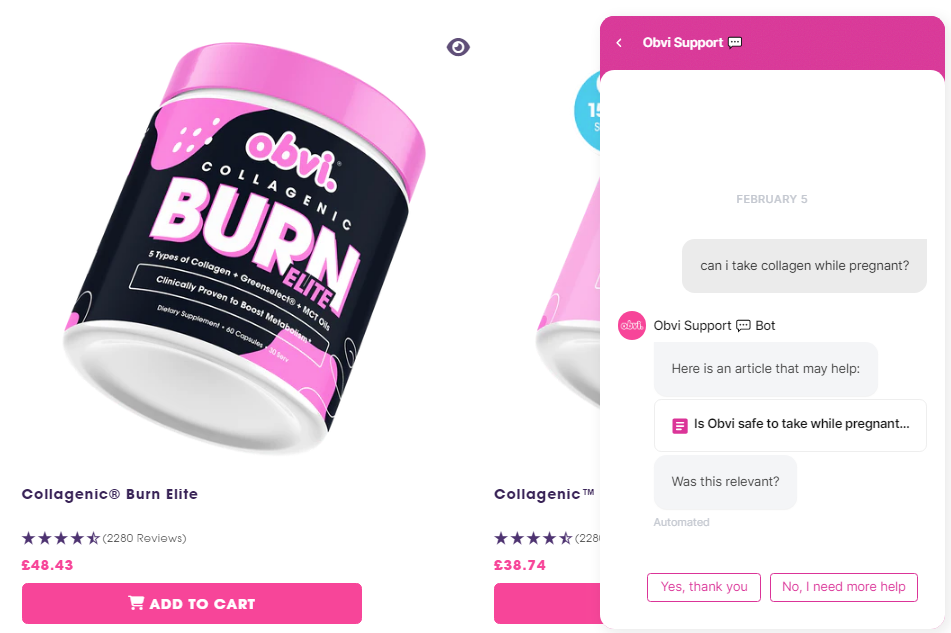
These chatbots have been found to reduce the resolution time to 5.4 minutes from 38 hours when compared to speaking to a customer support agent.
✅ Save money from not hiring customer support agents and help your customers solve their problems quicker.
❌ Not all problems can be resolved from the chatbots. You'd still need to have customer support agents to answer complex questions.
#4: Cross-selling & Upselling Products
E-commerce stores are increasing their average order value (AOV) by using AI-powered cross-selling and upselling.
The AI technology analyzes customer data to predict which products a customer might be interested in, or what's already in their basket.
After that, the tool generates sections in the product or category pages with recommended products.
For example, Big Sir's AI (that's us) can automatically generate:
- ''Picked for you'' product module that displays a selection of products that your customers are most likely to purchase.
- ''Frequently bought together'' product module that appears when a user adds a product to cart.
- ''Top sellers'' product module that shows the best-selling product in the product category.
Example: Wyze utilized Big Sur AI's cross-selling features to improve their average basket sizes and conversion rate.

💡Cross-selling and upselling do not have to take place on the website only.
You can enable personalized email recommendations (based on interactions on the website), in-app suggestions, or targeted advertisements.
✅ Improve your average basket sizes and conversion rate.
❌ Too much product choice can confuse customers.
#5: Hyper-Personalization
E-commerce brands are investing in hyper-personalization to tailor every aspect of the shopping experience to each customer.
AI technology and machine learning are used to personalize the customer experience based on their behavior on the website and product preferences.
We already covered personalization in terms of product recommendations and cross-selling.
But websites do not stop there - they are using AI to personalize the whole layout of the home pages to cater to each customer's preferences.
Example: Amazon shows its users custom home pages that are based on their product preferences and items bought so far.
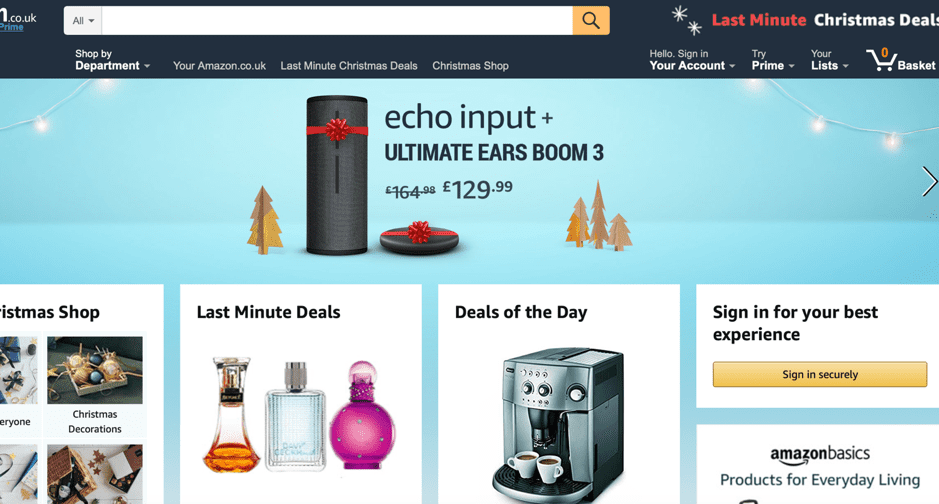
Hyper-personalization allows Amazon to stand out with its customer experience, as only 15% of online brands say that they've fully implemented personalization across their channels.
✅ Improve customer loyalty and improve your conversion rates by tailoring your website to each specific customer.
❌ Deep personalization requires a good amount of user data to work with. It's not optimized for first-time users.
#6: Logistics Optimization
AI technology can analyze large amounts of data (both consumer and commercial) to forecast consumer demand for products so brands can manage their inventories.
Such predictive analysis allows brands to reduce their logistics costs by up to 15% and improve their inventory levels by up to 35%.
The technology analyzes data from inventory levels, shipping routines, and seasonality to improve operational efficiency and streamline supply chains.
Example: Danone implemented an AI-powered machine learning system that can forecast product demand for their promotional campaigns.
The brand was able to plan how many products each promotion would sell, and they reported a 20% reduction in forecast error and a 30% reduction in lost sales.

✅ Prepare your brand for seasonality and product demand during promotions to reduce operational errors.
❌ These AI-powered insights are not going to be the ultimate truth, but smart estimations.
#7: Pricing Optimization
One of the best AI use cases in e-commerce is to dynamically adjust pricing to better compete with competitors and capture demand.
The technology can analyze customer behavior on your website and provide suggestions for flexible pricing changes throughout the month or year so you can capture seasonal demand.
Dynamic pricing also helps you compete with your competitors on prices.
The software can monitor competitor pricing changes and make automatic changes accordingly.
Example: eBay is using AI to adjust product prices in real-time based on their supply and demand, competitor prices, and historical sales data.
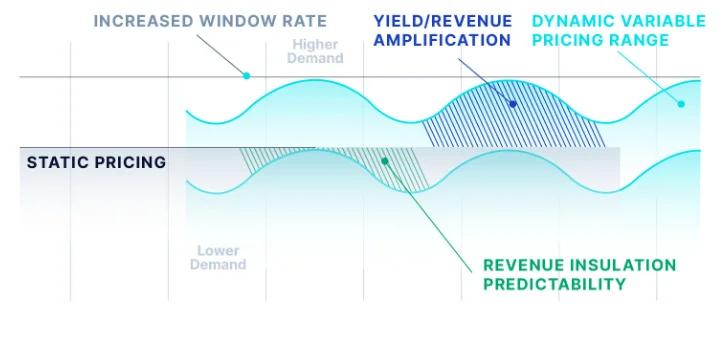
Image from Dealavo on how dynamic pricing works in eBay.
✅ AI-powered dynamic pricing allows brands to stay competitive, and be prepared for seasonal fluctuations.
❌ It's possible to confuse and upset your customers, and to start a pricing war with your competitors.
#8 Creating a Virtual Try-On
Since there are no fitting rooms in online stores, large online brands have tried to recreate that experience on their websites with AI-powered Virtual Reality.
You can develop virtual product try-ons where your customers can test how your products look on their bodies.
The technology employs Virtual Reality that uses a customer's phone or webcam to apply a chosen product in a virtual dressing room.

Example: Sephora created a virtual try-on experience where their customers can test make-up on their faces, using their phone's camera.
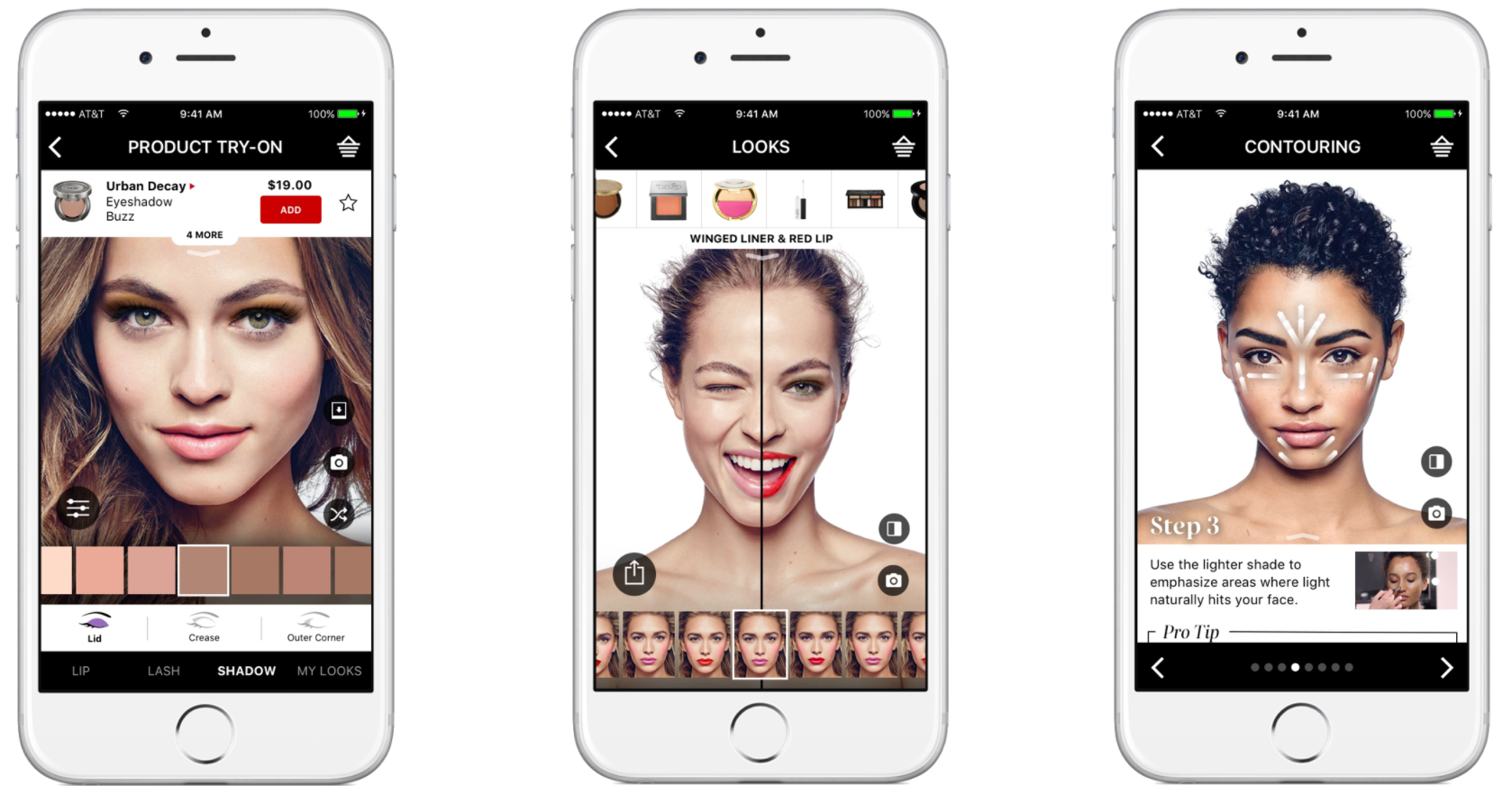
The brand reported a 35% increase in conversion rate and a 25% increase in add-to-basket rate.
Sephora's virtual try-on is also capable of making personalized skincare recommendations tailored to each customer's face.
✅ Improve the customer shopping experience by allowing them to virtually try how well your products will fit them so you can improve your conversion rates.
❌ The technology has been reported to not work that well in all lighting conditions or on all devices.
#9: Fraud Detection
Online retailers are using AI to prevent fraud.
These AI-powered fraud-detecting systems are using machine learning algorithms to analyze transaction patterns and detect unnatural consumer behavior.
The AI tools can alert you of fraud attempts and can secure financial transactions.
Use cases include:
- Detect Card Not Present (CNP) fraud where a stolen credit card is used to make a purchase online without physically presenting the card.
- When customers input incorrect shipping addresses, which is something that a human would not be able to spot right away.
- Spot fake reviews and flag them for removal.
Example: eBay utilizes AI technology to detect fake listings or suspicious payment transactions to maintain trust in the platform.
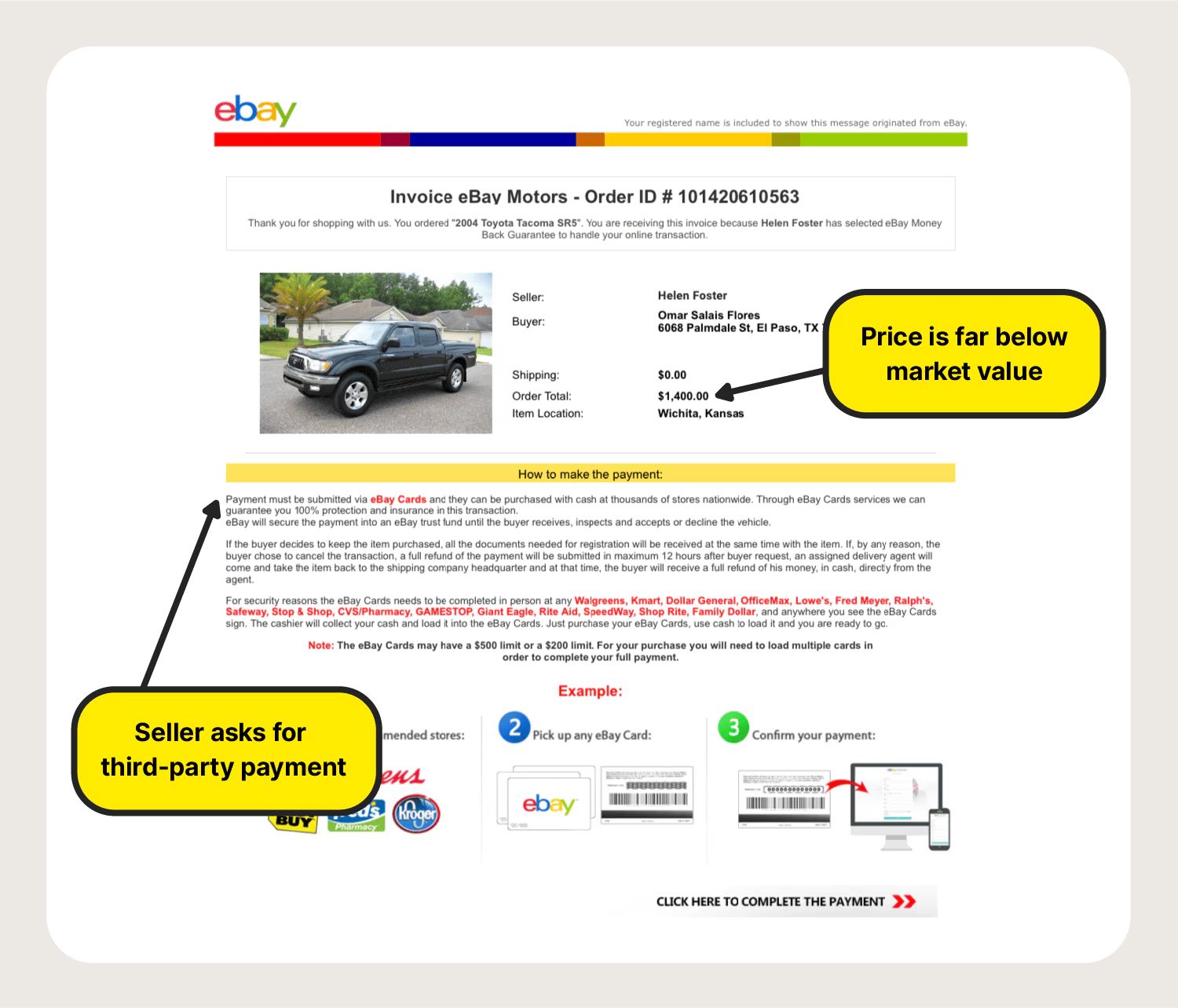
✅ Protect the quality and reliability of your website by analyzing thousands of transactions and customer behavior for potential frauds.
❌ AI can't keep up with all kinds of fraud, as cybercriminals constantly change their strategies.
#10: Insights into Customer Behavior
E-commerce brands utilize AI-powered analytics to gain deeper insights into customers' preferences, needs, and on-site behavior.
You can use AI-powered analytics for better customer segmentation to personalize your advertising campaigns and product recommendations to each user.
With this segmentation, retailers can offer a higher level of personalization, increasing conversion rates by up to 50%.
One more use case of AI analytics is identifying customer pain points and areas of opportunity after analyzing hundreds of conversations from the chatbots.
Example: Brands are using Big Sur AI's conversation insights from the AI chatbot to uncover the top questions people ask when they are searching for a product.
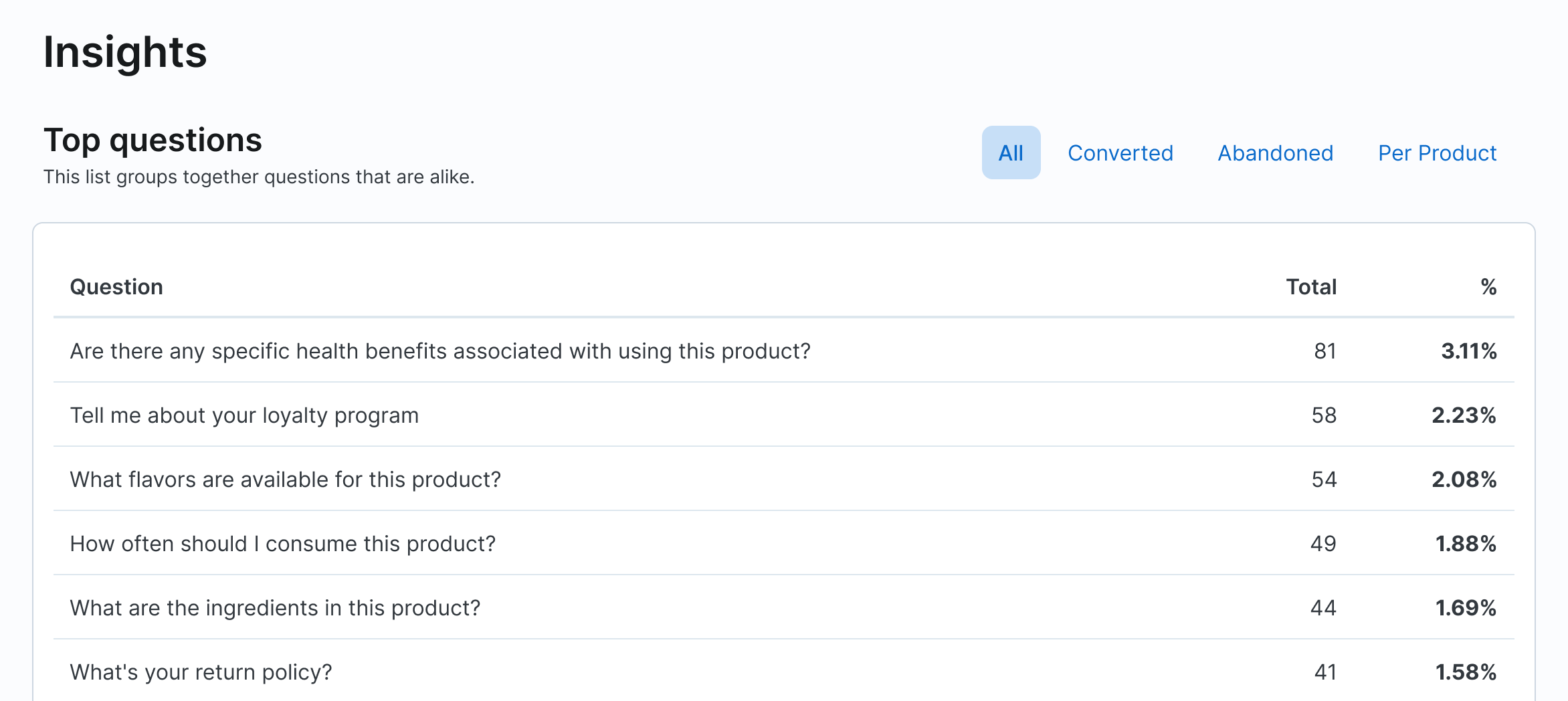
The software provides the conversion rate of each question, meaning that merchants can optimize their product pages for the highest-converting questions.
You can uncover the most important pre-purchase questions your consumers have in mind.
What are the best AI tools for E-Commerce?
Now that we've gone over the best use cases of AI in e-commerce, you can check out our updated guide of the 10 best AI tools for e-commerce in 2025.
We cover each tool's use cases, pricing structure, and drawbacks.
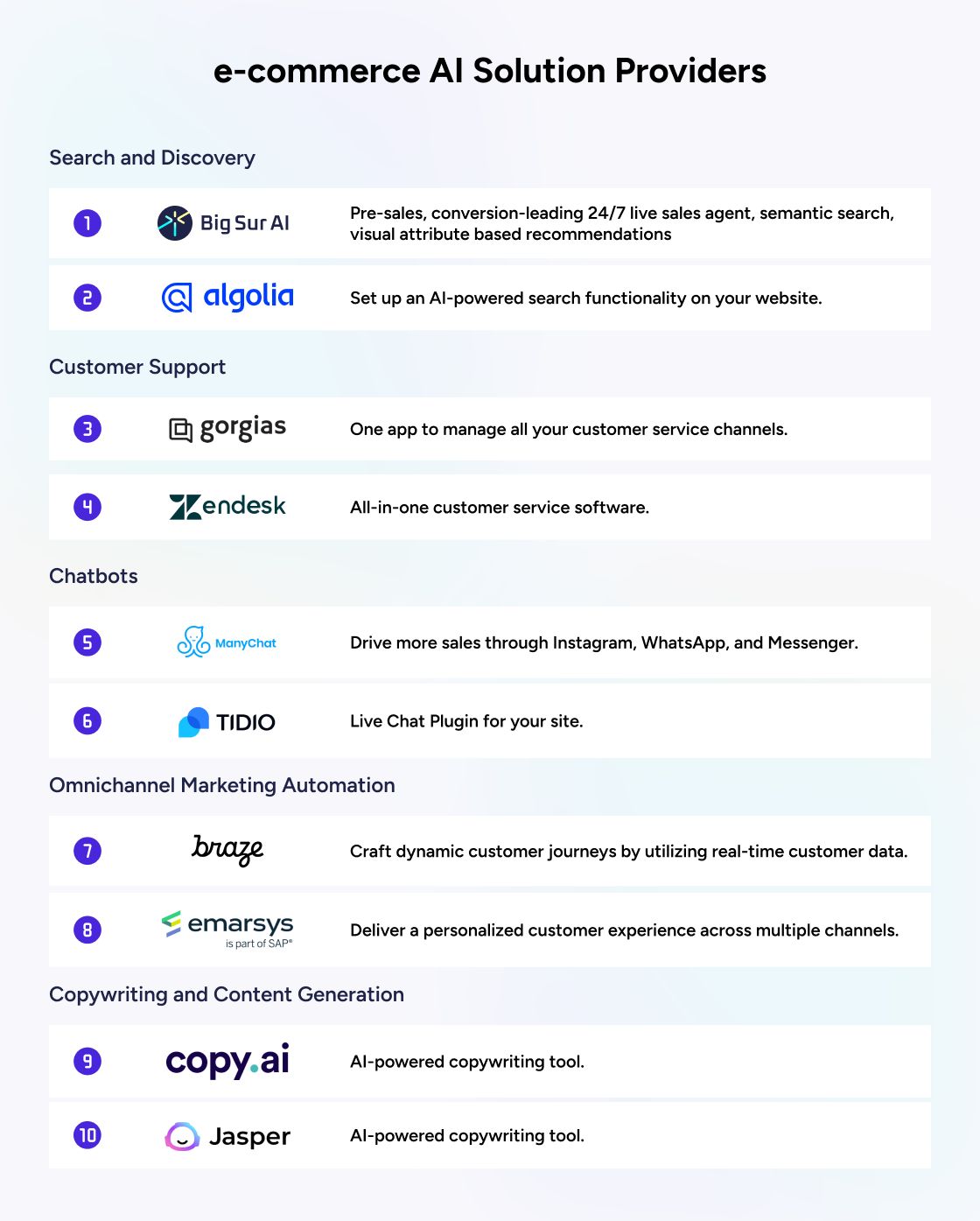
Wrap-Up
The e-commerce space has become more competitive with the emergence of AI technology.
Brands are already using AI to improve their conversion rates and operational efficiencies.
With the size of the AI market in e-commerce expected to reach $14 billion over the next few years, brands cannot afford to ignore artificial intelligence for long.
And expectations are growing, as 24% of 16-24-year-olds and 29% of 25-34-year-olds said they are likely to leave a website if their product search experience is not personalized.
The best place to start your search for AI tools is to evaluate which tools can provide a positive return on investment (ROI) via personalization, product recommendations, or data-driven cross-selling.
If you're looking for an AI tool that can increase your conversion rate by assisting your customers find the right products for them, give Big Sur AI a go.
💡Users who interact with our AI-powered chatbot convert at 4x the rate of the average user at a store.

